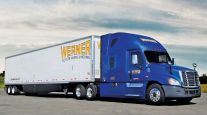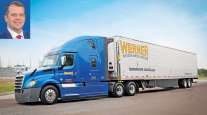Managing Editor, Features and Multimedia
Trucking Rises to Meet Unprecedented Challenges During COVID-19 Pandemic
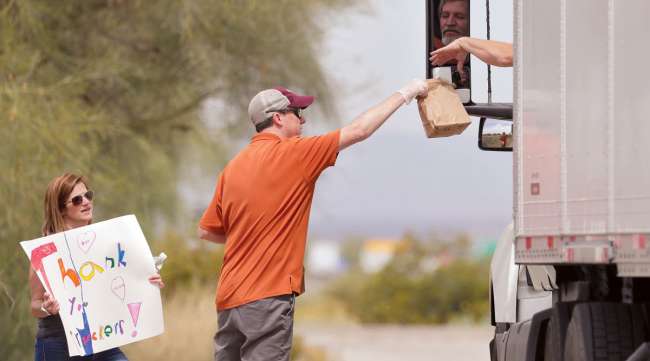
[Stay on top of transportation news: Get TTNews in your inbox.]
Businesses closed their doors and people sheltered at home this spring as the COVID-19 pandemic claimed lives and crippled the U.S. economy, but through it all, the commercial trucks that move the majority of America’s freight continued to roll down the nation’s highways.
Truck drivers have been among the front-line responders to the pandemic, delivering medical supplies and equipment to hospitals and ensuring that store shelves across the country remained stocked with essential goods for consumers.
Although this public health crisis has roiled supply chains and inflicted financial hardship on many transportation and logistics companies, it also will be remembered as a time when the trucking industry’s essential role within our society has never been clearer.
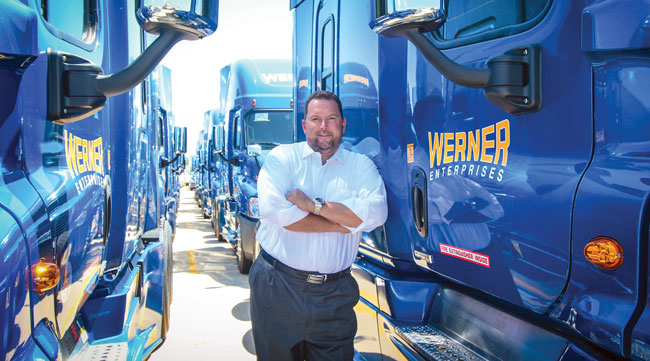
Werner CEO Derek Leathers says drivers have taken special pride in delivering supplies during the COVID-19 pandemic (Werner Enterprises)
“I hope the recognition of the value of the supply chain and the importance of the American truck driver lives well beyond this pandemic,” said Derek Leathers, CEO of truckload carrier Werner Enterprises.
“I think a light has been shined on how important they are to the U.S. economy, and I hope that carries forward.”
Werner Enterprises ranks No. 16 on the Transport Topics Top 100 list of the largest for-hire carriers in North America.
At the same time, fleets have faced unprecedented challenges during this difficult time.
After an initial surge in consumer demand in the early days of the pandemic, freight volumes weakened dramatically in many sectors of the transportation industry after states issued stay-at-home orders beginning in late March, shutting down large swaths of the economy.
Many retailers, manufacturers, restaurants and other businesses temporarily closed down or slowed production while Americans adhered to social distancing guidelines to reduce the spread of the highly contagious coronavirus, which had taken the lives of more than 100,000 Americans as of late May.
By then, states had begun taking gradual steps toward reopening the economy, but uncertainty continued to surround the development of a vaccine, the timing of an economic recovery and the long-term effects of the crisis.
The business impact of COVID-19 has varied significantly from one trucking company to the next.
Fleets surveyed for Transport Topics’ annual Top 100 ranking of the largest for-hire carriers in North America described a range of experiences, with some citing steady volumes or even upticks in demand, while many more saw freight volumes drop precipitously.
One fleet cited compressed margins and sporadic volumes in what typically were consistent lanes.
Another said its revenue plummeted by 40% to 50%.
The financial strain forced some companies to temporarily furlough employees or even make significant labor reductions in line with revenue losses.
On the other hand, driver retention has improved during the pandemic, according to one company.
Fleets said shipper customers in industrial sectors such as automotive and manufacturing have cut production, thus reducing freight demand.
The energy sector also experienced a major downturn.
Transport Services of Sullivan, a bulk carrier based in Sullivan, Ill., saw business levels drop by about 50% during the pandemic.
“We’ve been very devastated,” company President Jon England said. “We were doing really well right up until the time this all happened, and then it went south fast.”
The fleet, which operates 35 power units and 48 trailers, delivers fuel to gas stations and transports ethanol.
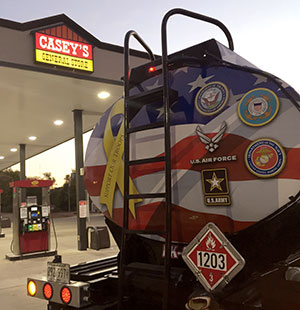
A tank truck belonging to Transport Services of Sullivan delivers fuel at a Casey's General Store. (Transport Services of Sullivan)
Despite the dramatic drop in demand, England said he has been able to keep all of his workers employed. Working with its local bank, Transport Services of Sullivan was able to secure a small-business loan under the federal Coronavirus Aid, Relief, and Economic Security Act.
“I can tell you, it was a game changer for me,” England said.
The fleet also saved significant cash flow because Daimler Trucks North America was willing to furlough three months’ worth of payments on his trucks, he added.
While much of the industrial sector slowed to a crawl, business levels increased for certain consumer packaged goods and in many areas of the health care and food and beverage sectors.
The pandemic also accelerated growth in e-commerce as millions of consumers became more accustomed to shopping online for a broader range of products in lieu of visiting brick-and-mortar stores.
XPO Logistics experienced “incredible demand” in its e-commerce business while nonessential businesses were closed and people stayed at home, said Erik Caldwell, chief operations officer for the company’s Supply Chain division.
“It feels like we’re in the Thanksgiving peak for e-commerce,” Caldwell told Transport Topics in late April.
Amid all of this market volatility, trucking companies have been taking steps to protect their workers from COVID-19 as they deliver essential freight.
XPO Logistics ranks No. 3 on the Transport Topics Top 100 list of the largest for-hire carriers in North America
Across the industry, fleets have been providing drivers with hand sanitizer, masks and gloves while establishing physical distancing measures in their terminals and warehouses. At the same time, many back-office employees transitioned to working remotely from their homes during the pandemic.
Trucking’s Response to COVID-19
Across the country, trucking companies have been a core component of the nation’s response to the pandemic.
XPO Logistics, for example, has been shipping food, water and crucial medical supplies and equipment into areas with high concentrations of COVID-19 cases, such as New York and Louisiana.
That work includes expediting hundreds of shipments of N95 medical face masks, visors and other supplies to hospitals, fire departments and police stations.
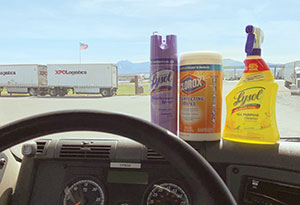
Cleaning products are used by XPO Logistics drivers to help keep them safe while on the road. (XPO Logistics)
XPO also has been managing medical and relief supplies in support of hard-hit New York City’s emergency management department.
The company said it was moving up to 10 times more ventilators and four times more medical beds than usual in March. It also cited increases of up to 40% in orders for food and health care supplies.
Werner Enterprises also participated in a variety of relief work as the pandemic took hold in the United States.
The carrier delivered products ranging from masks and gloves to paper products and 55-gallon barrels of hand sanitizer to locations across the country.
Professional drivers at Werner have taken pride in the importance of these relief loads and have been sharing photos of their bills of lading when hauling essential items such as medical masks or ventilators, Leathers said.
They’re just so proud of the work they’re doing and the difference they feel like they’re making, which has been really cool to see.
Werner CEO Derek Leathers
Werner also assisted its home state of Nebraska in its efforts to obtain personal protective equipment.
The company’s logistics division utilized its global network to procure more than 500,000 protective gloves, 300,000 N95 masks and 5,000 infrared thermometers for the state.
The state government initially reached out to Werner to provide over-the-road transportation of those goods, but the trucking company also offered to manage procurement, shipping and logistics for those supplies amid the global rush to secure PPE.
“It’s something we’re proud of because it’s really shown our ability to get things done when others weren’t able to,” Leathers said.
Freight Market Disruption
While panic buying and the demand for relief supplies initially caused volumes to surge in some portions of the freight market, other industry segments saw demand drop dramatically.
XPO cited a downturn in the automotive and aerospace sectors as those customers slowed production or shifted to making products to help with the pandemic.
At the same time, however, the company managed tremendous demand in the health care business. At one XPO warehouse, volumes for hospital cleaning materials were running eight times higher than normal, Caldwell said.
The food and beverage sector also saw strong demand in the early going as consumers stockpiled food, he said, citing “just an incredible spike in volume” for starches such as pasta and rice.
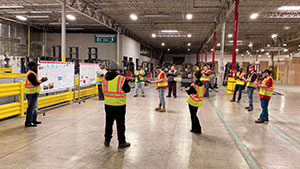
XPO warehouse workers maintain social distancing during a meeting. (XPO Logistics)
Meanwhile, XPO has adjusted its operations at facilities where business has been slow.
“In some places, we’ve been able to change the focus of the warehouse,” Caldwell said. “We do customized sewing for a customer, and when they shut down stores, we flipped the sewing over to making masks for all the warehouse workers and for the drivers. They’re making thousands and thousands of masks, constantly, every day, that we can send out to the field as we continue to get more.”
Leathers said Werner saw higher freight volumes when the pandemic first began to take hold due to the high demand for relief supplies, cleaning products, paper and other staple goods. But volumes started to wane in April due to lower overall consumption caused by business closures and stay-at-home orders.
The pocket surges in relief supplies combined with dramatically lower volumes in other markets have created major disruptions in logistics networks, Leathers added. This imbalance will test transportation companies’ ability to optimize in real time and adapt to rapidly changing market conditions, he said.
Brent Higgins Trucking, a small refrigerated carrier based in Mulberry, Ark., encountered less market volatility than many other fleets.
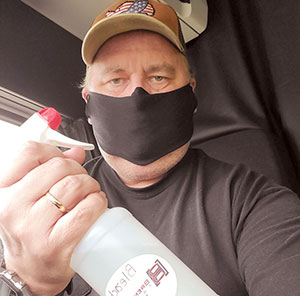
Drivers for Brent Higgins Trucking are given cleaning supplies to sanitize their trucks. (Brent Higgins Trucking)
Company owners Brent and Connie Higgins said business has been relatively consistent, in large part because the majority of its operations are tied to food and grocery stores.
“That’s why we haven’t seen the wild swings,” Brent said.
In the early days of the pandemic, however, truck capacity was in high demand during the rush to restock shelves.
“At the beginning, there was an influx of phone calls and emails to get us to cover loads,” Connie said. “We satisfy our regular customers first, and even they were asking if we had additional capacity.”
Driver Recognition
Trucking’s crucial role in the response to the pandemic has not gone unnoticed by the public, or even the highest levels of government.
Truck drivers have received an outpouring of gratitude — everything from simple words of appreciation and “Thank you truckers” signs at customers’ locations to a formal event on the White House lawn celebrating trucking’s essential work on the front lines.
“Throughout this crisis, professional truck drivers have been there, delivering for all of us,” American Trucking Associations President Chris Spear said. “They have delivered to hospitals, markets and homes, keeping our nation moving forward. It is unfortunate that it took a global pandemic for these heroes to get the recognition they so richly deserve, but we are pleased to see them receive it now and we’re proud to have this opportunity to recognize them as the heroes they are.”
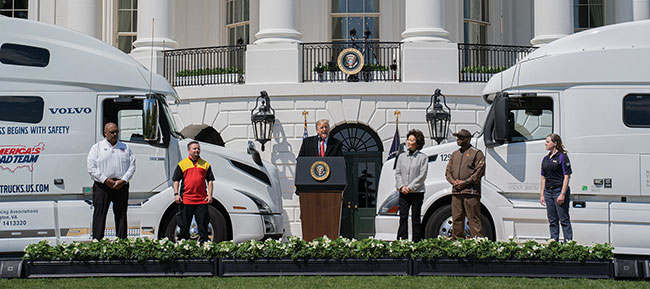
President Donald Trump, flanked by professional drivers and Transportation Secretary Elaine Chao, speaks during an April 16 event at the White House celebrating truckers' efforts during the pandemic. (Jeremy Kirkpatrick/ATA)
Werner’s Leathers agreed that the pandemic has highlighted the essentiality of transportation workers who are too often overlooked.
He recalled seeing two young kids waving a sign and offering free lemonade to truckers in front of a farmhouse on a country road in Nebraska.
“It’s heartwarming to see people respond to the work that the men and women of trucking are doing, and I just hope that nobody forgets when all of this passes,” Leathers said. “They’re just as important tomorrow as they are today, and the same with next year and into the future.”
Team blue wants to thank Fort Calhoun Elementary's Ms. Shupe and Ms. Hall's kindergarten classes for drawing these awesome pictures for our professional drivers! pic.twitter.com/aREYE1gBJl — Werner Enterprises (@One_Werner) May 16, 2020
Some of Brent Higgins Trucking’s shipper customers have been providing drivers with complimentary snacks and water during the pandemic.
Members of the public also have stepped up to assist drivers.
“At least one of our employees informed me that a complete stranger in another state went to a drive-thru, bought a meal and just delivered it to his truck. A lot of those acts of kindness have been going on,” Connie Higgins said.
Truck drivers and warehouse workers have always moved the world forward, but the public appreciates that work “probably more so now than ever before,” XPO’s Caldwell said.
“It’s really great to see the appreciation of the country in recognizing how much great work they do and how important that role is, and how it touches every aspect of our lives,” he said.
Worker Safety
Unlike many other professions, drivers and warehouse workers cannot work remotely from the comfort of their homes.
Carriers and logistics firms have taken steps to help protect their employees from the virus as they carry out their duties.
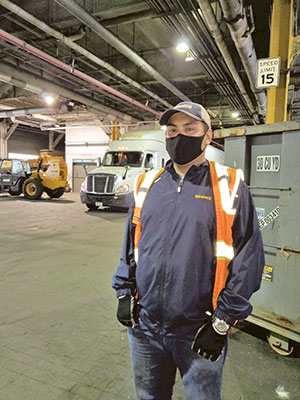
A Werner Enterprises driver wears a mask and gloves to ensure safety on the road. (Werner Enterprises)
Companies have been providing their drivers with large amounts of masks, gloves, hand sanitizer and cleaning products, but obtaining those supplies hasn’t always been easy. Werner, for example, partnered with a couple of distilleries to produce and bottle private-label sanitizer in large volumes so the company could keep its fleet in stock, Leathers said.
Out on the road, drivers have been using cleaning products to wipe down high-contact touch points, such as the cab interior, and truck and trailer doors.
Fleets also have been taking steps to reduce driver interaction at shipper and consignee locations, in part by converting some paper bills of lading to electronic forms.
Companies have taken similar precautions in the warehouse environment.
XPO, for one, has used lines of tape to mark out work spaces on its warehouse floors to ensure that employees maintain social distancing standards. The company also has implemented thermal temperature scanning at distribution centers.
Overcoming Challenges
As much of the U.S. economy shut down to fight the spread of COVID-19, a key concern for the trucking industry was ensuring that drivers continued to have places to eat and rest.
Restaurants across the country closed their doors and shifted to takeout-only service during the pandemic. However, many made accommodations for professional drivers to park at their locations and order food on their mobile apps for delivery to their trucks.
“The biggest challenge early on was making sure our drivers had availability to food,” Leathers said. “And although those challenges have been overcome as it relates to the availability of food, the reality is they’re still living in a grab-and-go world, and that’s not sustainable long term.”
The closure of public rest areas in some locations was another key concern during the initial response to the pandemic.
Trucks stops across the US are open for business -- and they're planning to stay that way https://t.co/2i7TVHp7aQ — CNN (@CNN) March 21, 2020
The trucking industry and the Federal Motor Carrier Safety Administration have been working with state and local governments to ensure that those public rest areas reopen or remain open, Leathers said.
The major truck stop chains have kept their restrooms, showers and fuel pumps open and sanitized during the pandemic, he added.
Meanwhile, driver detention time has increased at both shippers and consignees, due in large part to the added safety protocols and precautions.
On the positive side, transit times have improved by 2% to 3% because there has been less traffic congestion, but that efficiency gain has been more than offset by the increases in dwell time, Leathers said.
Enduring Changes
See the 2020 Top 100 rankings
►Top 100 For-Hire Interactive Map
►How the Coronavirus Pandemic Might Reshape Trucking's Future
►Pandemic Exacts Heavy Financial Toll on Trucking Companies
►Sanitation, Social Distancing Become New Normal in Trucking
Sector Rankings
LTL | TL/Dedicated
Intermodal/Drayage
Motor Vehicle/Driveaway
Tank/Bulk | Air/Expedited
Refrigerated | Flatbed/HS
Package/Courier | Mail
Household Goods/Commercial
Questions remain about the duration of the COVID-19 pandemic and the timing and speed of an economic rebound, but this crisis likely will leave an indelible mark on the transportation industry.
Businesses may start to think differently about inventory management, for example.
“Lean works really well most of the time, but during a large-scale supply chain disruption, you can see the challenges of being just in time,” XPO’s Caldwell said. “I think customers are probably going to segment their inventory not just on speed of turn or value, but also on the level of criticality of need, specific to getting resupply.”
The pandemic also may generate more momentum for the near-shoring of manufacturing in Mexico and South America versus Asia, he added.
Another permanent change could be the formation of deeper relationships among shippers, carriers and third-party logistics providers to enable all parties to better react to future disruptions.
“I think the level of communication and coordination between customers and carriers has increased because projections are changing daily, and we need that information to do our jobs,” Leathers said. “And I hope that we can all agree that this level of communication is where we need to be going forward.”
In time, businesses and consumers will settle into a new normal, but the trucking industry, and society in general, will feel reverberations from the pandemic for years to come.
Want more news? Listen to today's daily briefing:
Subscribe: Apple Podcasts | Spotify | Amazon Alexa | Google Assistant | More



